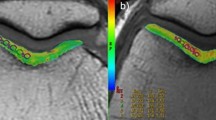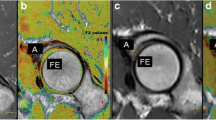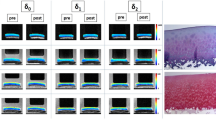Abstract
Purpose
To determine in vivo biomechanical properties of articular cartilage and cartilage repair tissue of the patella, using biochemical MRI by means of quantitative T2 map**.
Methods
Twenty MR scans were achieved at 3T MRI, using a new 8-channel multi-function coil allowing controlled bending of the knee. Multi-echo spin-echo T2 map** was prepared in healthy volunteers and in age- and sex-matched patients after matrix-associated autologous chondrocyte transplantation (MACT) of the patella. MRI was performed at 0° and 45° of flexion of the knee after 0 min and after 1 h. A semi-automatic region-of-interest analysis was performed for the whole patella cartilage. To allow stratification with regard to the anatomical (collagen) structure, further subregional analysis was carried out (deep–middle–superficial cartilage layer). Statistical analysis of variance was performed.
Results
During 0° flexion (decompression), full-thickness T2 values showed no significant difference between volunteers (43 ms) and patients (41 ms). Stratification was more pronounced for healthy cartilage compared to cartilage repair tissue. During 45° flexion (compression), full-thickness T2 values within volunteers were significantly increased (54 ms) compared to patients (44 ms) (p < 0.001). Again, stratification was more pronounced in volunteers compared to patients. The volunteer group showed no significant increase in T2 values measured in straight position and in bended position. There was no significant difference between the 0- and the 60-min MRI examination. T2 values in the patient group increased between the 0- and the 60-min examination. However, the increase was only significant in the superior cartilage layer of the straight position (p = 0.021).
Conclusion
During compression (at 45° flexion), healthy patellar cartilage showed a significant increase in T2-values, indicating adaptations of water content and collagen fibril orientation to mechanical load. This could not be observed within the patella cartilage after cartilage repair (MACT) of the patella, most obvious due to a lack of biomechanical adjustment.
Level of evidence
III.





Similar content being viewed by others
References
Alparslan L, Winalski CS, Boutin RD et al (2001) Postoperative magnetic resonance imaging of articular cartilage repair. Semin Musculoskelet Radiol 5(4):345–363
Apprich S, Mamisch TC, Welsch GH et al (2011) Quantitative T2 map** of the patella at 3.0T is sensitive to early cartilage degeneration, but also to loading of the knee. Eur J Radiol 81(4):e438–e443
Battaglia M, Vannini F, Buda R et al (2011) Arthroscopic autologous chondrocyte implantation in osteochondral lesions of the talus: mid-term T2-map** MRI evaluation. Knee Surg Sports Traumatol Arthrosc 19(8):1376–1384
Brittberg M, Faxen E, Peterson L (1994) Carbon fiber scaffolds in the treatment of early knee osteoarthritis. A prospective 4-year followup of 37 patients. Clin Orthop Relat Res 307:155–164
Brittberg M, Lindahl A, Nilsson A et al (1994) Treatment of deep cartilage defects in the knee with autologous chondrocyte transplantation. N Engl J Med 331(14):889–895
Bydder M, Rahal A, Fullerton GD et al (2007) The magic angle effect: a source of artifact, determinant of image contrast, and technique for imaging. J Magn Reson Imaging 25(2):290–300
Chung CB, Frank LR, Resnick D (2001) Cartilage imaging techniques: current clinical applications and state of the art imaging. Clin Orthop Relat Res 391(Suppl):S370–S378
D’Anchise R, Manta N, Prospero E et al (2005) Autologous implantation of chondrocytes on a solid collagen scaffold: clinical and histological outcomes after two years of follow-up. J Orthopaed Traumatol 6:36–43
Eckstein F, Lemberger B, Gratzke C et al (2005) In vivo cartilage deformation after different types of activity and its dependence on physical training status. Ann Rheum Dis 64(2):291–295
Felson DT (2004) Risk factors for osteoarthritis: understanding joint vulnerability. Clin Orthop Relat Res 427(Suppl):S16–S21
Goodwin DW, Zhu H, Dunn JF (2000) In vitro MR imaging of hyaline cartilage: correlation with scanning electron microscopy. Am J Roentgenol (AJR) 174(2):405–409
Huberti HH, Hayes WC (1984) Patellofemoral contact pressures. The influence of q-angle and tendofemoral contact. J Bone Joint Surg Am 66(5):715–724
Jones CW, Willers C, Keogh A et al (2008) Matrix-induced autologous chondrocyte implantation in sheep: objective assessments including confocal arthroscopy. J Orthop Res 26(3):292–303
Kocher MS, Steadman JR, Briggs KK et al (2004) Reliability, validity, and responsiveness of the Lysholm knee scale for various chondral disorders of the knee. J Bone Joint Surg Am 86-A(6):1139–1145
Liess C, Lusse S, Karger N et al (2002) Detection of changes in cartilage water content using MRI T2-map** in vivo. Osteoarthr Cartil 10(12):907–913
Madry H, van Dijk CN, Mueller-Gerbl M (2010) The basic science of the subchondral bone. Knee Surg Sports Traumatol Arthrosc 18(4):419–433
Mamisch TC, Trattnig S, Quirbach S et al (2010) Quantitative T2 map** of knee cartilage: differentiation of healthy control cartilage and cartilage repair tissue in the knee with unloading—initial results. Radiology 254(3):818–826
Marcacci M, Berruto M, Brocchetta D et al (2005) Articular cartilage engineering with Hyalograft C: 3-year clinical results. Clin Orthop Relat Res 435:96–105
Marlovits S, Kutscha-Lissberg F, Aldrian S et al (2004) Autologous chondrocyte transplantation for the treatment of articular cartilage defects in the knee joint. Techniques and results. Radiologe 44(8):763–772
Marlovits S, Trattnig S (2006) Cartilage repair. Eur J Radiol 57(1):1–2
Mosher TJ, Dardzinski BJ, Smith MB (2000) Human articular cartilage: influence of aging and early symptomatic degeneration on the spatial variation of T2-preliminary findings at 3 T. Radiology 214(1):259–266
Mosher TJ, Smith HE, Collins C et al (2005) Change in knee cartilage T2 at MR imaging after running: a feasibility study. Radiology 234(1):245–249
Poole AR, Kojima T, Yasuda T et al (2001) Composition and structure of articular cartilage: a template for tissue repair. Clin Orthop Relat Res 391(Suppl):S26–S33
Recht M, White LM, Winalski CS et al (2003) MR imaging of cartilage repair procedures. Skeletal Radiol 32(4):185–200
Rubenstein JD, Kim JK, Henkelman RM (1996) Effects of compression and recovery on bovine articular cartilage: appearance on MR images. Radiology 201(3):843–850
Salsich GB, Ward SR, Terk MR et al (2003) In vivo assessment of patellofemoral joint contact area in individuals who are pain free. Clin Orthop Relat Res 417:277–284
Shiomi T, Nishii T, Myoui A et al (2010) Influence of knee positions on T2, T*2, and dGEMRIC map** in porcine knee cartilage. Magn Reson Med 64(3):707–714
Smith HE, Mosher TJ, Dardzinski BJ et al (2001) Spatial variation in cartilage T2 of the knee. J Magn Reson Imaging 14(1):50–55
Tegner Y, Lysholm J (1985) Rating systems in the evaluation of knee ligament injuries. Clin Orthop Relat Res 198:43–49
Trattnig S, Ba-Ssalamah A, Pinker K et al (2005) Matrix-based autologous chondrocyte implantation for cartilage repair: noninvasive monitoring by high-resolution magnetic resonance imaging. Magn Reson Imaging 23(7):779–787
Watrin-Pinzano A, Ruaud JP, Cheli Y et al (2004) Evaluation of cartilage repair tissue after biomaterial implantation in rat patella by using T2 map**. MAGMA 17(3–6):219–228
Welsch GH, Mamisch TC, Domayer SE et al (2008) Cartilage T2 assessment at 3-T MR imaging: in vivo differentiation of normal hyaline cartilage from reparative tissue after two cartilage repair procedures—initial experience. Radiology 247(1):154–161
Welsch GH, Mamisch TC, Zak L et al (2010) Evaluation of cartilage repair tissue after matrix-associated autologous chondrocyte transplantation using a hyaluronic-based or a collagen-based scaffold with morphological MOCART scoring and biochemical T2 map**: preliminary results. Am J Sports Med 38(5):934–942
White LM, Sussman MS, Hurtig M et al (2006) Cartilage T2 assessment: differentiation of normal hyaline cartilage and reparative tissue after arthroscopic cartilage repair in equine subjects. Radiology 241(2):407–414
Conflict of interest
All authors disclose that there are no financial and/or personal relationships with other individuals or organizations that could inappropriately influence (bias) this work.
Author information
Authors and Affiliations
Corresponding author
Rights and permissions
About this article
Cite this article
Pachowsky, M.L., Trattnig, S., Wondrasch, B. et al. In vivo evaluation of biomechanical properties in the patellofemoral joint after matrix-associated autologous chondrocyte transplantation by means of quantitative T2 MRI. Knee Surg Sports Traumatol Arthrosc 22, 1360–1369 (2014). https://doi.org/10.1007/s00167-013-2527-7
Received:
Accepted:
Published:
Issue Date:
DOI: https://doi.org/10.1007/s00167-013-2527-7




